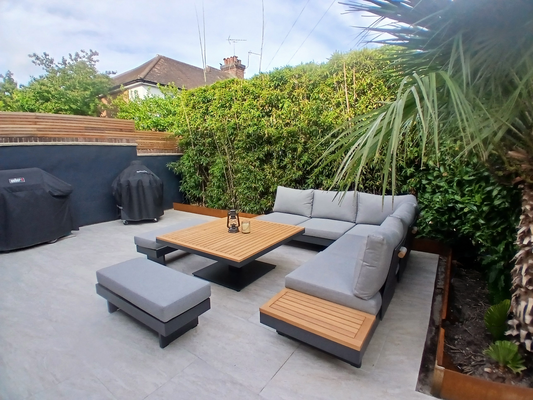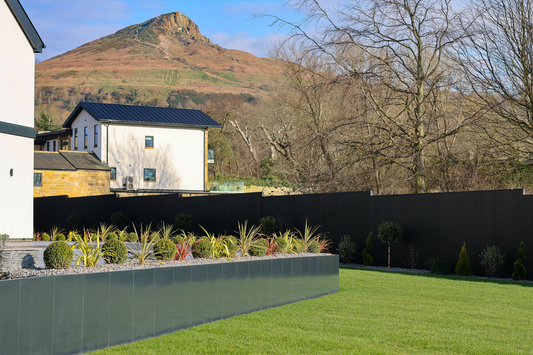
Choosing the right material for your garden edging is one of the most important decisions you’ll make when designing your outdoor space. The right edging not only defines your garden's structure but also complements its overall aesthetic and serves practical purposes like soil retention and weed control. With so many options available, it can be overwhelming to decide which material best suits your needs.
This guide will help you navigate through the pros, cons, and ideal applications of the most popular garden edging materials.

Why Garden Edging Material Matters
Garden edging material plays a crucial role in:
- Aesthetic Appeal: It’s a visible element that frames your garden, so it should align with your overall style.
- Durability: The material needs to withstand weather, soil conditions, and potential impacts from lawn equipment.
- Functionality: Different materials excel at different tasks, from retaining soil to creating defined pathways.
- Ease of Installation: Some materials are DIY-friendly, while others require professional installation.
Popular Materials for Garden Edging
Here’s a breakdown of the most common edging materials to help you make an informed choice.
1. Steel Edging
Steel edging is known for its strength, sleek design, and ability to create both straight and curved lines. It’s a modern choice that suits contemporary gardens and is excellent for achieving a polished, professional look.
Advantages:
- Long-lasting and resistant to wear.
- Ideal for defining clean lines.
- Available in various finishes to match your design preferences.
Disadvantages:
- Can be more expensive than other materials.
- Requires proper installation for stability.
Example: Groundline Garden Edging offers flexible steel options that are perfect for both functional and decorative use.
2. Concrete Edging
Concrete is a versatile material that can be poured in place or used in pre-formed sections. It provides a clean and permanent solution.
Advantages:
- Highly durable and weather-resistant.
- Can be customized with stamps, stains, or paints.
- Great for formal gardens and high-traffic areas.
Disadvantages:
- Requires professional installation for best results.
- Limited flexibility for curved designs.
3. Timber Edging
Timber adds a rustic and natural feel to gardens. It’s an affordable choice that’s easy to install but may require regular maintenance.
Advantages:
- Blends well with natural landscapes.
- Easy to cut and shape.
- Affordable and widely available.
Disadvantages:
- Susceptible to rot and pests over time.
- Requires treatment for longevity.
Tip: For vegetable gardens, untreated timber may be a safer option to avoid chemical leaching.
4. Natural Stone Edging
Stone edging offers timeless beauty and works well in a variety of garden styles, from formal to rustic.
Advantages:
- Extremely durable and weather-resistant.Provides a natural look that blends seamlessly with plants.
- Can be arranged in creative patterns.
Disadvantages:
- Labor-intensive to install.
- Higher initial cost compared to other materials.
5. Plastic Edging
Plastic is a lightweight and cost-effective option, often used for quick fixes or temporary borders.
Advantages:
- Easy to install and manipulate.
- Affordable and widely available.
- Suitable for DIY projects.
Disadvantages:
- Less durable than other materials.
- Can appear less polished or professional.
6. Brick or Paver Edging
Bricks and pavers are versatile materials that add charm and structure to garden edges. They’re often used for pathways and formal gardens.
Advantages:
- Wide range of colours and styles available.
- Durable and long-lasting.
- Easy to replace individual pieces if damaged.
Disadvantages:
- Requires precise installation for stability.
- Can shift over time without proper base preparation.
Factors to Consider When Choosing Edging Materials
1. Garden Style
The material should complement the overall theme of your garden. For example:
- Modern gardens often benefit from sleek steel or concrete edging.
- Cottage-style gardens pair well with timber or natural stone.
2. Functionality
Determine the primary purpose of your edging:
- To retain soil: Opt for sturdy materials like concrete or steel.
- To define pathways: Flexible materials like steel or bricks work well.
- To create raised beds: Consider systems like the Contour Raised Bed System.
3. Budget
Materials like plastic and timber are more budget-friendly, while steel and natural stone often come at a premium. Keep in mind that higher upfront costs for durable materials can save money in the long run.
4. Ease of Installation
If you’re planning a DIY project, choose materials that are straightforward to install, such as plastic, timber, or pre-formed concrete.
Advanced Solutions for Modern Landscapes
For those seeking cutting-edge options, consider specialized systems designed for both aesthetics and functionality:
- Contour Raised Beds: Perfect for creating dynamic, elevated garden areas with customizable shapes and heights.
- Anco Retaining Wall System: Ideal for structural needs in sloped landscapes, providing both durability and a modern aesthetic.
- Contain Planter Range: Modular planters that can double as edging for flexible, stylish designs.
Final Thoughts
The material you choose for your garden edging can have a lasting impact on the beauty, functionality, and maintenance of your outdoor space. Consider your garden’s style, needs, and budget when making your decision. Whether you’re drawn to the sleek lines of steel edging or the rustic charm of natural stone, there’s a perfect solution for every landscape.
Start exploring innovative options like Groundline Garden Edging or Contour Raised Bed Systems to elevate your garden design today.



